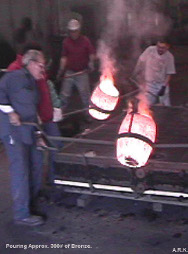The Lost Wax Method
Jim Franklin uses the process of lost-wax casting, a process in which bronze is cast from his sculpture. Almost any material can be used to make a cast from, Jim uses wet-clay, pours a wax (or any other suitable material that can burn out) reproduction from the cast of the clay and then finally cast the bronze from the wax.
The steps to go from the clay model to the finished bronze are as follows:
- Jim creates a sculpture out of wet clay. These include the bas-reliefs on boards and the clay sculptures he displays in his studio.
- After the clay sculpture is complete, he creates a rigid plaster mold with sometimes a soft inner layer like silicone to capture delicate details in wax. The molds are made in pieces that are securely held in place once it is time to pour a wax mold.
- When the mold is ready to use, it is assembled and molten wax (very hot liquified wax) is poured in and swished around to form an even coating on the inner surface of the mold.
- The hollow wax is removed from the mold. More copies can be made from the mold until the mold loses its durability.
- The wax copies are refined using hot metal tools to smooth out any rough spots and other tools to add further texture and detail.
- The ready wax copies are sprued, that is created passages through which liquid material, the bronze, is introduced into a mold. The spruing will be melted out later in the process and will not affect the finished sculpture.
- The wax copy now gets dipped into a silica slurry, then into sand or dry crystaline silica and dried. This repeated process builds up a shell that covers the piece.
- The pieces is then placed in a kiln which heats the silica coatings into a hard shell and the wax melts and runs out, leaving behind a hollow shell.
- The shell is then cooled and tested for cracks and leaks and patched if there are any.
- The shell is heated and the melted metal is poured into the shell from a crucible. Once the silica shells are filled, they must completely cool.
- Now the sculpture is released from its shell by hammering or sand blasting the silica layer away and the spruings are cut off.
- The bronze sculpture is then filed, polished, or finished in the desired manner.




